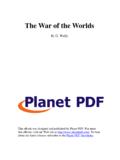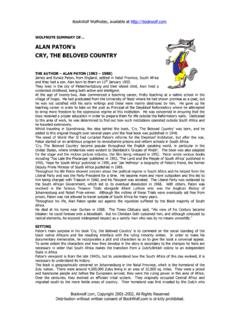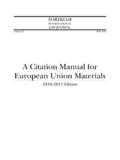Transcription of LEARNING EACH OTHER’S HISTORICAL …
1 LEARNING EACH other S HISTORICAL narrative : palestinians and IsraelisThis is a preliminary draft of the English translationThis project and publication of this booklet havebeen made possible by:The Public Affairs Offices of The United States Embassy, Tel Aviv, The United States Consulate General, Wye River PRIME PublicationPeace Research Institute in the Middle Box 7 Beit Jallah, PNAM arch 2003 LEARNING EACH other S HISTORICAL narrative : palestinians and IsraelisSami Adwan Co-director of PRIME; Project coordinatorDan Bar-On Co-director of PRIME; Project coordinatorAdnan Musallam Consultant, Palestinian HistoryEyal Naveh Consultant, israeli HistoryShoshana Steinberg Observer and evaluatorLinda Livni Administrative AssistantTeachersTeachersTeachersTeacher sTeachersLeiana Abu-FarhaKhalil BadenNiv KeidarEshel KlinhouseSara MaorShai MiselmanRula MuslehSunia RajabeAbdel Halim TumaiziYousuf TumaiziNaomi VeredRachel ZamirInternational participantsInternational participantsInternational participantsInternational participantsInternational participantsHuweida ArrafMichelle GawercAdena Scytron-WalkerAdam ShapiroJessica WeinbergTranslatorsTranslatorsTranslator sTranslatorsTranslatorsShimon Ben-Naim Language editor.
2 Hebrew Arabic translationYoav SternArabic Hebrew translationINTRODUCTIONINTRODUCTIONINTRO DUCTIONINTRODUCTIONINTRODUCTIONS choolchildren studying history in times of war orconflict learn only one side of the story theirown which is, of course, considered to be the right one. Teaching is often doctrinaire, its pur-pose to justify one side while presenting a nega-tive portrait of the other . One side s hero is theother side s informs us that textbooks usually focuson the conflict, with its human losses and suffer-ing, while periods of peace or coexistence betweenthe two sides are neglected. In a certain respectteachers become the nation s cultural emissariesand are expected to emphasize the goodness oftheir own side versus the evil of the believe that teachers can be trained to be em-issaries for peace-building, to teach both sides nar-ratives and to allow their pupils to question whatthey learn regarding both narratives.
3 A peaceagreement, of course, makes it easier for the teach-ers to do so, for in the normal course of eventsnations then change their educational curricula toreflect a culture of peace rather than one of PRIME we appreciate the importance of educa-tion and school textbooks in peace-building, andwe are well aware that the situation between Pal-estinians and Israelis these days is not a peacefulone. Therefore, developing a booklet that includesthe Palestinian and israeli narratives of three im-portant HISTORICAL events the Balfour Declaration,the 1948 war and the 1987 Palestinian Intifada has not been an easy this project, six high school history teachers fromeach side worked together to develop the twonarratives, which were translated into Arabic orHebrew so the booklet could be published in bothlanguges. Our purpose was not to criticize or tochange the narratives, nor is it realistic at this stageto develop a single, joint booklet gives both teachers and pupils theopportunity to learn the other s narratives.
4 It wasdesigned so that on each page, in between thePalestinian and israeli narratives, there is space forpupils to write their own comments. In December2002 the teachers who helped develop the projectbegan teaching the narratives to their 9th and 10thgrade know that this process is not without prob-lems or difficulties, and consider it to be an experi-ment in education. We will follow-up and draw con-clusions about the success of the project by not-ing the reactions and comments of pupils andteachers. This data will enable us to recommendthe future development and revision of school text-books and teaching regard history as an attempt to build a betterfuture by looking under every rock rather thanrather than throwing them at each other . We hopeyou teachers and pupils will share our visionand join us in undertaking the Adwan, Dan Bar-On, Adnan MusallamSami Adwan, Dan Bar-On, Adnan MusallamSami Adwan, Dan Bar-On, Adnan MusallamSami Adwan, Dan Bar-On, Adnan MusallamSami Adwan, Dan Bar-On, Adnan Musallamand Eyal Navehand Eyal Navehand Eyal Navehand Eyal Navehand Eyal NavehYousuf Tumaizi (1957 2002) was born in the vil-lage of Idna.
5 He was arrestedmore than 20 times andspent several years in Israeliprisons. He had BA in became a peace activistand took part in projects andactivities the object of whichwas to build peace, under-standing and died on August 19, 2002,the first day of the thirdseminar for this project,which he had planned to at-tend. He is survived by a wifeand five children, the young-est just four months old atthe time of his the very beginning hewas a most enthusiastic sup-porter of this the Balfour DeclarationFrom the Balfour DeclarationFrom the Balfour DeclarationFrom the Balfour DeclarationFrom the Balfour Declarationto the first White Paperto the first White Paperto the first White Paperto the first White Paperto the first White PaperIntroductionIntroductionIntroductio nIntroductionIntroductionThe birth of the Zionist movementThe birth of the Zionist movementThe birth of the Zionist movementThe birth of the Zionist movementThe birth of the Zionist movementZionism, the Jewish national movement, was born inthe 19th century when the ideology embodied in theEnlightenment was disseminated in the European Jew-ish community.
6 These new ideas planted the firstseeds of Jewish nationalism; the subsequent birth ofZionism was the result of several factors:1) The rise of modern anti-Semitism a deeply-rootedand complicated mixture of traditional religioushatred augmented by scientific racism which cat-egorized Jews as a depraved and pernicious ) The disappointment of western European Jewswith the emancipation which pledged that the po-sition of Jews in society would equal that of theChristians. The Jews were discouraged when it be-came clear that in many instances there was equal-ity in name only. Discrimination ) New European nationalist movements such asthose appearing in Italy and Germany inspired simi-lar aspirations among the ) An important element was the longing for Zion,an integral aspect of Jewish religious and nationalidentity throughout history.
7 This longing stemmedfrom the biblical promise that the land of Israelwas given to the people of Israel by the God ofIsrael, and on memories of those HISTORICAL eraswhen the people of Israel lived independently intheir land. This concept inspired the national an-them, written at that time:Hatikvah: The HopeHatikvah: The HopeHatikvah: The HopeHatikvah: The HopeHatikvah: The HopeAs long as in our heart of heartsthe Jewish spirit remains strong,And we faithfully look toward the east,Our eyes will turn to Balfour DeclarationThe Balfour DeclarationThe Balfour DeclarationThe Balfour DeclarationThe Balfour DeclarationNovember 2, 1917 November 2, 1917 November 2, 1917 November 2, 1917 November 2, 1917 ContentsContentsContentsContentsContents * HISTORICAL background* Dividing the Arab East* Steps leading to the Balfour Declaration* Arrival of the Zionist Mission in Palestine (April1918) and Arab reaction* Arab reaction.
8 Popular uprisings, 1920 and 1929 MapsMapsMapsMapsMaps* Map of Palestine at the end of Ottoman Rule* Map of the Anglo-French-Russian Agreement the(Sykes-Picot Agreement) (May 1916)* Map of the Decisions of San Remo; Mandate (April1920)GlossaryGlossaryGlossaryGloss aryGlossaryReferencesReferencesReference sReferencesReferencesHistorical backgroundHistorical backgroundHistorical backgroundHistorical backgroundHistorical backgroundIn April 1799 Napoleon Bonaparte put forth a planfor a Jewish state in Palestine. During the siege ofAcre, he sought to enlist Jewish support in return forwhich he promised to build the Temple. The projectfailed after the defeat of Napoleon in the battles ofAcre and Abu-Qir. It represents the first post-Renais-sance expression of cooperation between a colonialistpower and the Jewish peopleHowever, it was the events of 1831-40 that pavedthe way for the establishment of a Jewish state inPalestine.
9 Lord Palmerston, the British Foreign Secre-tary in 1840-41, proposed establishing a British pro-tectorate in the Ottoman Empire to be settled byJews as a buffer area an obstacle to Mohammed Aliof Egypt and to political unity in the Arab NARRATIVEPALESTINIAN NARRATIVECHAPTER 1 PAGE 1 Chapter 1 Chapter 1 Chapter 1 Chapter 1 Chapter 1We have not yet lost our hope,The hope of two thousand years,To be a free people in our land The land of Zion and Zionist movement was born in the major centersof Jewish population in Europe, and its purpose wasto return the Jewish people to its land and put anend to its abnormal situation among the nations ofthe world. At first there was a spontaneous emer-gence of local associations ( Lovers of Zion ) out ofwhich an organized political movement was estab-lished, thanks to the activities of The Father of Zion-ism, Theodore Herzl [whose Hebrew name is BenjaminZe ev Herzl].
10 In 1882 there was a small wave of immigration [aliya/pl. aliyot] to the land [ , the land of Israel], thefirst of several. The purpose of these aliyot was notjust to fulfill the religious obligations connected tothe land, as had been the case in the past, but ratherto create a new kind of Jew, a productive laborerwho would work on his own land and help establish aJewish political entity in the land of 1897 the First Zionist Congress took place in Basle,Switzerland, and there the goals of the movementwere delineated (the Basle Plan): The purpose ofZionism is to create a refuge for the Jewish people inthe land of Israel, guaranteed by an open and officiallegal arrangement. There were two basic approaches to Zionism:1)Practical Zionism focused on increasing immigra-tion, purchasing land, and settling Jews on the 1914, in the first two waves of immigration,nearly 100,000 people immigrated (although mostof them later left the country).






